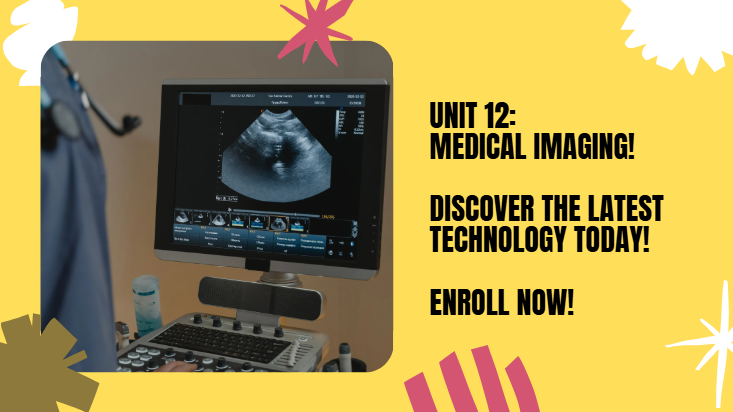PHYSICS S6 UNIT 12: MEDICAL IMAGING.

About Course
Medical imaging refers to the techniques and processes used to create visual representations of the interior of a body for clinical analysis, medical intervention, and the visual representation of the function of organs or tissues (physiology). It plays a crucial role in diagnosing and treating diseases by revealing internal structures hidden by the skin and bones, and also helps establish a database of normal anatomy and physiology to identify abnormalities.
Here’s a breakdown of key aspects of medical imaging:
1. Types of Medical Imaging Technologies:
-
X-ray Imaging (Radiography): The oldest and most common technique, using electromagnetic radiation to produce images based on varying tissue absorption. Dense tissues (like bone) appear white, while softer tissues appear darker. Used for diagnosing fractures, lung conditions, and in mammography (breast cancer detection).
-
Computed Tomography (CT or CAT scan): Builds upon X-ray technology to create detailed cross-sectional images. Multiple X-ray images taken from different angles are combined to provide 3D views of organs and tissues. Excellent for bones, soft tissues, and blood vessels, and used for diagnosing tumors, internal injuries, and heart disease.
-
Magnetic Resonance Imaging (MRI): Uses powerful magnets and radio waves to generate highly detailed images of soft tissues without ionizing radiation. Ideal for brain, spinal cord, muscles, and joint imaging, and for detecting conditions like torn ligaments and herniated discs.
-
Ultrasound (Sonography): Utilizes high-frequency sound waves to create real-time images of internal organs and tissues. Safe, minimally invasive, and radiation-free, making it popular for monitoring pregnancy, heart conditions, and abdominal issues. Can visualize blood flow (Doppler imaging).
-
Nuclear Medicine: Involves using small amounts of radioactive materials (tracers) to create images that display the body’s physiology, metabolism, and molecular function.
-
Positron Emission Tomography (PET) scans: Often used for cancer diagnosis and treatment, and to examine neurological and cardiovascular diseases by revealing metabolic activity.
-
Single-Photon Emission Computed Tomography (SPECT): Provides 3D images of organ functions.
-
-
Molecular Imaging: A broader term that includes using various methods (MRI, CT, PET) with a contrast agent to visualize, characterize, and quantify biological processes.
-
Fluoroscopy: Uses X-rays to obtain real-time moving images of the body’s interior, often used for guiding procedures like stent placement.
-
Mammography: A specialized X-ray technique for breast cancer detection.
-
Bone Densitometry (DEXA): Uses X-rays to measure bone mineral density, helping diagnose osteoporosis.
-
Optical Coherence Tomography (OCT): Provides high-resolution, cross-sectional images of biological tissues, widely used in ophthalmology.
2. Applications of Medical Imaging:
Medical imaging has a wide range of applications:
-
Diagnosis: Identifying abnormalities, diseases (e.g., cancer, heart disease, neurological disorders), and injuries (e.g., fractures, internal bleeding).
-
Disease Progression Monitoring: Tracking the advancement or regression of a disease, such as tumor size in cancer patients or Parkinson’s disease progression.
-
Treatment Planning: Allowing surgeons to determine the extent of surgery, plan radiation therapy, or guide needle procedures for biopsies.
-
Evaluating Treatment Efficacy: Assessing if a treatment regimen has been effective, for example, checking if a tumor has diminished in size after chemotherapy.
-
Age-Related Calculations: Determining fetal age through ultrasound or skeletal age using hand-wrist radiographs.
-
Tissue Engineering and Artificial Tissues: Imaging artificial tissues implanted in the body and evaluating scaffold structures.
3. Advancements and Future Trends:
The field of medical imaging is constantly evolving, driven by technological innovations and increasing demand. Key trends include:
-
Artificial Intelligence (AI) and Machine Learning: Revolutionizing image analysis, aiding in early disease detection, precise diagnosis, and personalized treatment plans. AI can automate time-consuming tasks, improve diagnostic accuracy, retrieve old records for comparison, and assist in large-scale screening.
-
Advanced Imaging Modalities: Continued development and increased utilization of complex studies like CT and PET scans. New emerging technologies like photon-counting CT, digital SPECT, and whole-body MRI are being introduced.
-
3D and 4D Imaging: Providing detailed, dynamic views of anatomical structures, enhancing surgical planning and outcomes (e.g., 4D CT perfusion imaging for stroke management).
-
Hybrid Technologies: Combining different modalities for more comprehensive insights (e.g., PET-CT, PET-MRI fusion systems merging metabolic and anatomical data).
-
Personalized Imaging: Moving away from a one-size-fits-all approach to tailoring imaging to specific patients based on their individual needs and conditions.
-
Accessibility and Portability: Development of portable and low-cost imaging solutions (e.g., handheld ultrasound) to expand patient access, especially in rural or underserved areas, and to reduce wait times.
-
Remote Scanning Technology: Allowing expert technologists to operate imaging equipment from a distance, improving efficiency and access.
-
Sustainability (“Green Radiology”): Growing awareness of the environmental impact of high-tech equipment is leading to a focus on energy-efficient designs, recyclable materials, and responsible disposal of hazardous materials.
-
Integration with Electronic Health Records (EHRs): Enhanced digital workflows, better image storage and retrieval, and seamless integration with patient data for more complete patient summaries and informed decision-making.
Course Content
X-RAY IMAGING.
-
Introduction.
14:32 -
Interaction of X-rays with matter.
24:21 -
X-rays Imaging Techniques.
21:47 -
Checking my progress.
28:15
ULTRASONIC IMAGING.
SCINTIGRAPHY (NUCLEAR MEDICINE).
MAGNETIC RESONANCE IMAGING (MRI).
ENDOSCOPY.
END UNIT ASSESSMENT
Questions and Answers
Final Unit Exam
Student Ratings & Reviews

